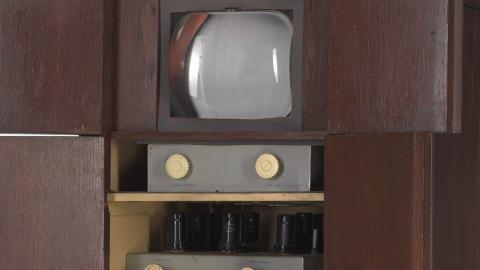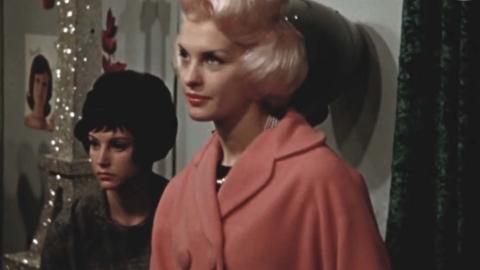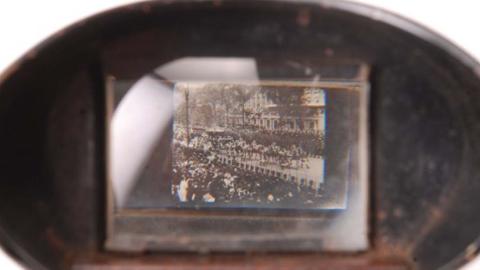
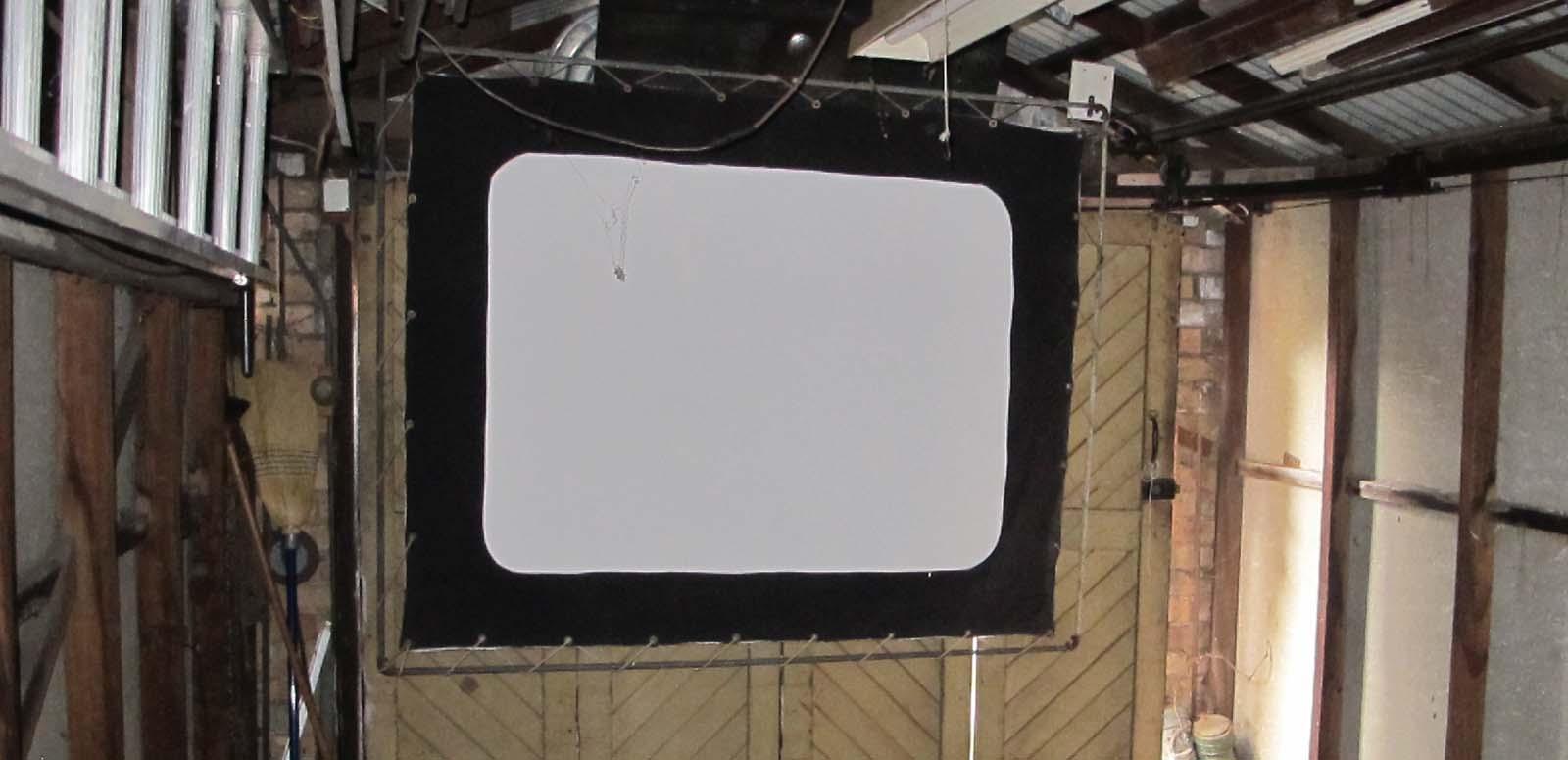
Home cinema, 1940s style
Eddie Vormister's homemade film projector
Just before his 100th birthday, Eddie Vormister contacted the NFSA about donating his homemade film projector and home cinema set-up. Jess Bolton and Tara Marynowsky from the Film, Documents and Artefacts team visited him in Wollongong in 2017, where they were treated to a private screening.
Edward (Eddie) Vormister radiates a youthful spirit and deep sense of pride when reflecting on his homemade projector and his undying passion for the magic of the cinema experience. 'I look at the thing myself … and I can’t believe I built it, because it is absolutely perfect!'.
Eddie Vormister demonstrates his homemade film projector and home cinema, 2017.
DIY cinema
Born in January 1918, Eddie worked for a long time as an electrical engineer for Wollongong Council and spent many of his evenings employed as a projectionist in theatres throughout the Illawarra region, including the Regent Theatre, Civic Theatre and later as the Saturday night projectionist at the School of Arts Theatre in Balgownie. It was here at the School of Arts Theatre that Eddie operated a pair of Cummings and Wilson ‘junior’ (model P6) projectors.
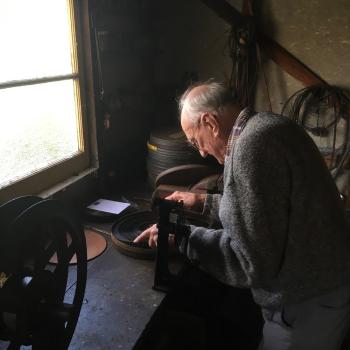
After three or four years operating them he decided it was time to make one. With a keen eye for detail and a love of tinkering in his workshop, Eddie set himself the challenge of manufacturing an exact replica of the 35mm projector.
In 1944 when Eddie began this endeavour, wartime restrictions meant that supplies of machinery and electrical parts were meagre. He had to be creative as even basic hardware – like screws, nuts and bolts –needed to be individually fabricated.
Teaching himself to cast metal from scraps and pistons collected from a local car yard, Eddie set up a foundry in his backyard and got to work. The only parts of the projector he needed to source elsewhere were the sound and light lenses.
Working on it every evening, most weekends and even Christmas Day, Eddie spent over 14 months and 2000 hours producing a perfect replica 35mm Cummings and Wilson projector. In the end, it cost him less than 20 pounds to build.
Sunday night at the movies
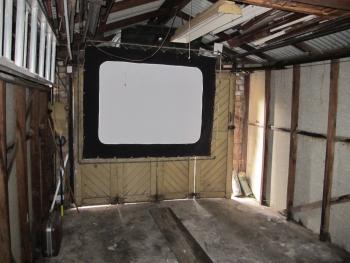
The real magic of Eddie’s creation came to life on Sunday evenings. On Saturday nights after his shift at the theatre, Eddie would borrow the latest release films (with approval from the cinema management) to screen at his home cinema. Every Sunday night for approximately ten years from 1944, 25 of Eddie’s close friends and family would squeeze into a small garage in the Wollongong suburb of Gwynneville for an evening of entertainment.
From his projection booth or ‘bio box’ (a small workshop at the rear of the garage) Eddie would play records on the turntable as guests arrived, in the same fashion as the commercial theatres. Through a small window between the workshop and the garage, Eddie would project the films onto a hand-built screen suspended from the ceiling.
I could have filled the garage ten times. Everybody would say ‘what about a show on Sunday, Ed?’ and I’d have to say, ‘I’m booked up this Sunday; you’ll have to wait ‘til next week!'
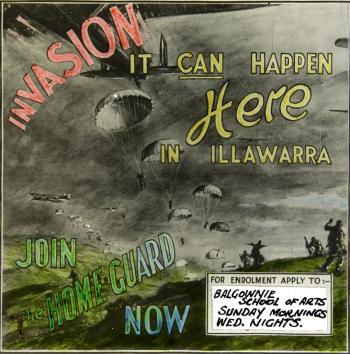
With the introduction of television in 1956, and the convenience of home entertainment, film attendance dwindled and cinemas began to close. Eddie stopped his regular screenings and his little home theatre closed its ‘roller’ door for the last time.
Since then Eddie’s projector and home cinema have been one of Wollongong’s best kept secrets, occasionally used for demonstrations for close family and friends but mostly gathering dust in the garage.
When we visited Eddie in Wollongong, he treated us to a private screening of a 1935 documentary, Along the South Coast Trail, about the Illawarra region featuring the steel works of Port Kembla and coastal attractions such as the Kiama blowhole.
In addition to Eddie’s projector, screen and speaker, the NFSA has acquired some glass slide advertisements, along with a handful of films and advertisements that Eddie screened.
In the short audio clip below, Eddie shares his remarkable story:
Eddie tells his story about building his projector and DIY cinema, 2017
This article was first published in 2017. The text was updated in 2023.
Want to be the first to hear stories and news from the NFSA?
Subscribe to our newsletter and never miss out.
Main image: Eddie Vormister's fold-down cinema screen in Wollongong, 2017.
The National Film and Sound Archive of Australia acknowledges Australia’s Aboriginal and Torres Strait Islander peoples as the Traditional Custodians of the land on which we work and live and gives respect to their Elders both past and present.
